Characterization of Geoheritage and Geotourism Potential of the Fluvial-Glacial Landscapes in the Culebrillas Lagoon (Ecuador)
Abstract
1. Introduction
2. Materials and Methods
2.1. Delimitation of the Study Area
2.2. Qualitative Characterization of the Elements of Interest Present in the Study Area
2.2.1. Geological and Geomorphological Analysis
2.2.2. Characterization and Identification of Sites of Biological, Cultural, and Ethnographic Interest
2.2.3. Qualitative Evaluation of the Identified Sites
2.2.4. Strategies for Using Identified Sites
3. Results
4. Discussion
5. Conclusions
Author Contributions
Funding
Conflicts of Interest
References
- Ramos, A. El desarrollo de la etnohistoria andina a través de la (re)definición de lo andino (1970–2005). Front. Hist. 2018, 23, 8–43. [Google Scholar] [CrossRef]
- Vivanco Pomacanchari, C. Obras hidráulicas de etapa prehispánica en Huaccana, Chincheros—Apurimac. Arqueol. Soc. 2015, 30, 315–333. [Google Scholar] [CrossRef]
- Reindel, M.; Isla, J. Cambio climático y patrones de asentamiento en la vertiente occidental de los Andes del sur del Perú. Diálogo Andin. 2013, 41, 83–99. [Google Scholar] [CrossRef]
- Levillier, R. Los Incas; Escuela de Estudios hispanoamericanos de Sevilla: Sevilla, Spain, 1956. [Google Scholar]
- Bar Esquivel, A. Afectaciones históricas a la red vial inca y la necesidad del estudio documentario de carreteras para la investigación y el registro de caminos prehispánicos. In Cuadernos del Qhapaq Ñan; Marcone Flores, G., Barraza Lescano, S., Eds.; Ministerio de Cultural del Perú: Proyecto Qhapaq Ñan, Peru, 2013; Volume 1, pp. 32–51. [Google Scholar]
- Hyslop, J. Qhapaq Ñan. In El Sistema Vial Incaico; Instituto de Estudios Arqueológicos (INDEA)-Petróleos del Perú: Lima, Peru, 1992. [Google Scholar]
- UNESCO. Qhapaq Ñan Sistema Vial Andino. In Nuevos Esfuerzos en Favor de su Conservación Sostenible; Organización de las Naciones Unidas para la Educación, la Ciencia y la Cultura: London, UK, 2021. [Google Scholar]
- ECOLAP; MAE. Guía del Patrimonio de Áreas Naturales Protegidas del Ecuador; ECOFUND, FAN, DarwinNet, IGM: Quito, Ecuador, 2007; pp. 165–175. [Google Scholar]
- de Velasco, J. Historia del Reino de Quito en la América Meridional (2 Tomos); Casa de la Cultura Ecuatoriana: Quito, Ecuador, 1789. [Google Scholar]
- Ortega Heras, M.J.; Atancuri Pacurucu, N.P. Los Nuevos descubrimientos de los Asentamientos Cañaris. Bachelor’s Thesis, Universidad Politécnica Salesiana, Cuenca, Ecuador, 2011. [Google Scholar]
- Newsome, D.; Dowling, R.K. Geotourism: The Tourism of Geology and Landscape; Goodfellow Publishers: Oxford, UK; London, UK, 2010. [Google Scholar] [CrossRef]
- Dowling, R.K. Global Geotourism—An Emerging Form of Sustainable Tourism. Czech J. Tour. 2012, 2, 59–79. [Google Scholar] [CrossRef]
- Newsome, D.; Dowling, R.K.; Leung, Y. The nature and management of geotourism: A case study of two establish iconic geotourism destinations. Tour. Manag. Perspect. 2012, 2–3, 19–27. [Google Scholar] [CrossRef]
- Hose, T.A. European “Geotourism”—Geological interpretation and geoconservation promotion for tourist. In Geological Heritage: Its Conservation and Management; Barretino, D., Wimbledon, W.P., Gallego, E., Eds.; Instituto Tecnológico Geominero de España: Madrid, Spain, 2000; pp. 127–146. [Google Scholar]
- Štrba, Ľ.; Kolačkovská, J.; Kudelas, D.; Kršák, B.; Sidor, C. Geoheritage and Geotourism Contribution to Tourism Development in Protected Areas of Slovakia—Theoretical Considerations. Sustainability 2020, 12, 2979. [Google Scholar] [CrossRef]
- Quesada-Valverde, M.E.; Quesada-Román, A. Worldwide Trends in Methods and Resources Promoting Geoconservation, Geotourism, and Geoheritage. Geosciences 2023, 13, 39. [Google Scholar] [CrossRef]
- White, S.; Wakelin King, G.A. Earth sciences comparative matrix: A comparative method for geoheritage assessment. Geogr. Res. 2014, 52, 168–181. [Google Scholar] [CrossRef]
- Štrba, L.U.; Rybár, P.; Baláž, B.; Molokáč, M.; Hvizdák, L.; Kršák, B.; Lukáč, M.; Muchová, L.; Tometzová, D.; Ferenčíková, J. Geosite assessments: Comparison of methods and results. Curr. Issues Tour. 2015, 18, 496–510. [Google Scholar] [CrossRef]
- Filocamo, F.; Rosskopf, C.M.; Amato, V. A contribution to the understanding of the Apennine landscapes: The potential role of Molise geosites. Geoheritage 2019, 11, 1667–1688. [Google Scholar] [CrossRef]
- Zolitschka, B.; Francus, P.; Ojala, A.E.K.; Schimmelmann, A. Varves in lake sediments—A review. Quat. Sci. Rev. 2015, 117, 1–41. [Google Scholar] [CrossRef]
- Lahee, F.H. (Ed.) Geología Práctica; Omega: Barcelona, Spain, 1985. [Google Scholar]
- Lugo Hubp, J. Elementos de Geomorfología Aplicada (Métodos Cartográficos); Instituto de Geografía, Universidad Nacional Autónoma de México: Mexico City, Mexico, 1988. [Google Scholar]
- Rodríguez Infante, A. Geomorfología. Available online: https://ninive.ismm.edu.cu/bitstream/handle/123456789/1661/RodriguezG.pdf?sequence=1&isAllowed=y#:~:text=La%20geomorfolog%C3%ADa%20como%20toda%20ciencia,naturalmente%20debe%20evitar%20las%20ilusiones (accessed on 1 March 2023).
- Coe, A.L.; Argles, T.W.; Rothery, D.A.; Spicer, R.A. Geological Field Techniques; John Wiley & Sons, Ltd.: London, UK, 2010. [Google Scholar]
- JAXA/METI. ALOS PALSAR L1.5 2011. Available online: https://asf.alaska.edu/ (accessed on 1 December 2022).
- Spradley, J. Participant Observation; Waveland Press, Inc.: Long Brove, IL, USA, 1980. [Google Scholar]
- Chhabra, D.; Healy, R.; Sills, E. Staged authenticity and heritage tourism. Ann. Tour. Res. 2003, 30, 702–719. [Google Scholar] [CrossRef]
- Cárdenas Ordóñez, G.S.; Quinteros Vicuña, G.E. Cañar Capital Arqueológica y Cultural del Ecuador: Análisis de su Declaración y Proyecciones. Bachelor’s Thesis, Universidad de Cuenca, Cuenca, Ecuador, 2011. [Google Scholar]
- Silva, P.G.; Bardají, T.; Roquero, E.; Baena-Preysler, J.; Cearreta, A.; Rodríguez-Pascua, M.A.; Rosas, A.; Zazo, C.; Goy, J.L. El Periodo Cuaternario: La Historia Geológica de la Prehistoria. Cuatern. Geomorfol. 2017, 31, 113–154. [Google Scholar] [CrossRef]
- Street-Perrott, F.A.; Roberts, N.; Metcalfe, S. Geomorphic implications of late Quaternary hydrological and climatic changes in the Northern Hemisphere tropics. In Environmental Change and Tropical Geomorphology; Douglas, I., Spencer, T., Eds.; Allen and Unwin: London, UK, 1985; pp. 164–183. [Google Scholar]
- Davis, W.M. The geographical cycle. Geogr. J. 1899, 14, 481–504. [Google Scholar] [CrossRef]
- Böse, M. From Morphostratigraphy to Chronostratigraphy—Modern Quaternary Geomorphology as a Basic for Climatic Research. Géomorphologie Relief Process. Environ. 2014, 20, 303–306. [Google Scholar] [CrossRef]
- Bennett, M.R.; Glasser, N.F. Glacial Geology: Ice Sheets and Landforms, 2nd ed.; Wiley-Blackwell: Oxford, UK, 2009; p. 385. [Google Scholar]
- Heine, K. Tropical South America during the Last Glacial Maximum: Evidence from glacial, periglacial and fluvial records. Quat. Int. 2000, 72, 7–21. [Google Scholar] [CrossRef]
- Rabatel, A.; Francou, B.; Soruco, A.; Gomez, J.; Cáceres, B.; Ceballos, J.L.; Basantes, R.; Vuille, M.; Sicart, J.E.; Huggel, C.; et al. Current state of glaciers in the tropical Andes: A multi-century perspective on glacier evolution and climate change. Cryosphere 2012, 7, 81–102. [Google Scholar] [CrossRef]
- Francou, B.; Rabatel, A.; Soruco, A.; Sicart, J.E.; Silvestre, E.E.; Ginot, P.; Cáceres, B.; Condom, T.; Villacís, M.; Ceballos, J.L.; et al. Glaciares de los Andes Tropicales Víctimas del Cambio Climático; CAN–PRAA–IRD: Quito, Ecuador, 2012; p. 99. [Google Scholar]
- Zemp, M.; Frey, H.; Gärtner-Roer, I.; Nussbaumer, S.U.; Hoelzle, M.; Paul, F.; Haeberli, W.; Denzinger, F.; Ahlstrøm, A.P.; Anderson, B.; et al. Historically unprecedented global glacier decline in the early 21st century. J. Glaciol. 2015, 61, 745–762. [Google Scholar] [CrossRef]
- Vuille, M.; Franquist, E.; Garreaud, R.; Casimiro, W.S.L.; Cáceres, B. Impact of the global warming hiatus on Andean temperature. J. Geophys. Res. Atmos. 2015, 120, 3745–3757. [Google Scholar] [CrossRef]
- Chang, K. A typology of settlement and community patterns in some circumpolar societies. In Arctic Anthropology; Madison University of Wisconsin Press: Madison, WI, USA, 1962; Volume 1, pp. 28–41. [Google Scholar]
- Prieto Rodríguez, M. Los patrones de asentamiento: Una herramienta metodológica para la reconstrucción del pasado. Boletín Antropológico 2011, 29, 116–131. [Google Scholar]
- Schwarz, S.; Migoń, P. When science and leisure meet: A geotourist itinerary in Southern Tierra del Fuego, Argentina. In Advances in Geomorphology and Quaternary Studies in Argentina; Rabassa, J., Ed.; Earth System Sciences; Springer: Berlin/Heidelberg, Germany, 2017; pp. 49–75. [Google Scholar] [CrossRef]
- Coronato, A.; Schwarz, S.; Flores Barrera, F. Glacial landforms as geodiversity resources for geotourism in Tierra del Fuego, Argentina. Quaest. Geogr. 2022, 41, 5–24. [Google Scholar] [CrossRef]
- Coronato, A.; Meglioli, A.; Rabassa, J. Glaciations in the Magellan Straits and Tierra del Fuego, Southernmost South America. In Quaternary Glaciations—Extent and Chronology. Part III; Ehlers, J., Gibbard, P., Eds.; Quaternary Book Series; Elsevier: Amsterdam, The Netherlands, 2004; pp. 45–48. [Google Scholar] [CrossRef]
- Duraj, M.; Niemiec, D.; Cheng, X.; Koleňák, P. Vestiges of Glacial Action in Ostrava: Their Significance for and Application in Geotourism. In Proceedings of the IOP Conference Series: Earth and Environmental Science, Zvenigorod, Russia, 4–7 September 2017; pp. 1–6. [Google Scholar] [CrossRef]
- Pessoa, G.E.; Steinke, V.A. The Relevance of the South American Nevados for Geoheritage. Geoheritage 2023, 15, 61. [Google Scholar] [CrossRef]
- Tavera Escobar, M.A.; Estrada Sierra, M.; Errázuriz Henao, C.; Hermelin, M. Georutas o itinerarios geológicos: Un modelo de geoturismo en el Complejo Volcánico Glaciar Ruiz-Tolima, Cordillera Central de Colombia. Cuad. Geogr. Rev. Colomb. Geogr. 2017, 26, 219–240. [Google Scholar] [CrossRef]
- Navarrete, E.; Morante-Carballo, F.; Dueñas-Tovar, J.; Carrión-Mero, P.; Jaya-Montalvo, M.; Berrezueta, E. Assessment of Geosites within a Natural Protected Area: A Case Study of Cajas National Park. Sustainability 2022, 14, 3120. [Google Scholar] [CrossRef]
- Gray, M. Other nature: Geodiversity and geosystem services. Environ. Conserv. 2011, 38, 271–274. [Google Scholar] [CrossRef]
- Buckley, R.C.; Cooper, M.A. Tourism as a Tool in Nature-Based Mental Health: Progress and Prospects Post-Pandemic. Int. J. Environ. Res. Public Health 2022, 19, 13112. [Google Scholar] [CrossRef] [PubMed]
- Carrillo, A. Informe de los Trabajos de Prospección, Limpieza y Relevamiento, Realizados en el Sitio Arqueológico “Culebrillas”, 1993–1997; Instituto Nacional de Patrimonio Cultural, Departamento de Arqueología: Cuenca, Ecuador, 1998. [Google Scholar]
- Idrovo Urigüen, J. Fluctuaciones del Nivel del Agua en la LAGUNA de Culebrillas, Provincia del Cañar, Prospección Arqueológica y Propuesta Para su Embalse; CEDIR-PROMAS: Cuenca, Ecuador, 2008. [Google Scholar]
- Alfaro Reyes, E.; Chalá Cruz, J.; Delgado Espinoza, F.; Eguiguren Eguiguren, A.; Guerrero Arias, P.; Herrera Montero, L.; María Larrea, A.; Rivadeneira Silva, M.; Sánchez-Parga, J.; Viteri, M.A. La Arqueología y la Antropología en Ecuador; Editorial Universitaria Abya-Yala: Quito, Ecuador, 2011. [Google Scholar]
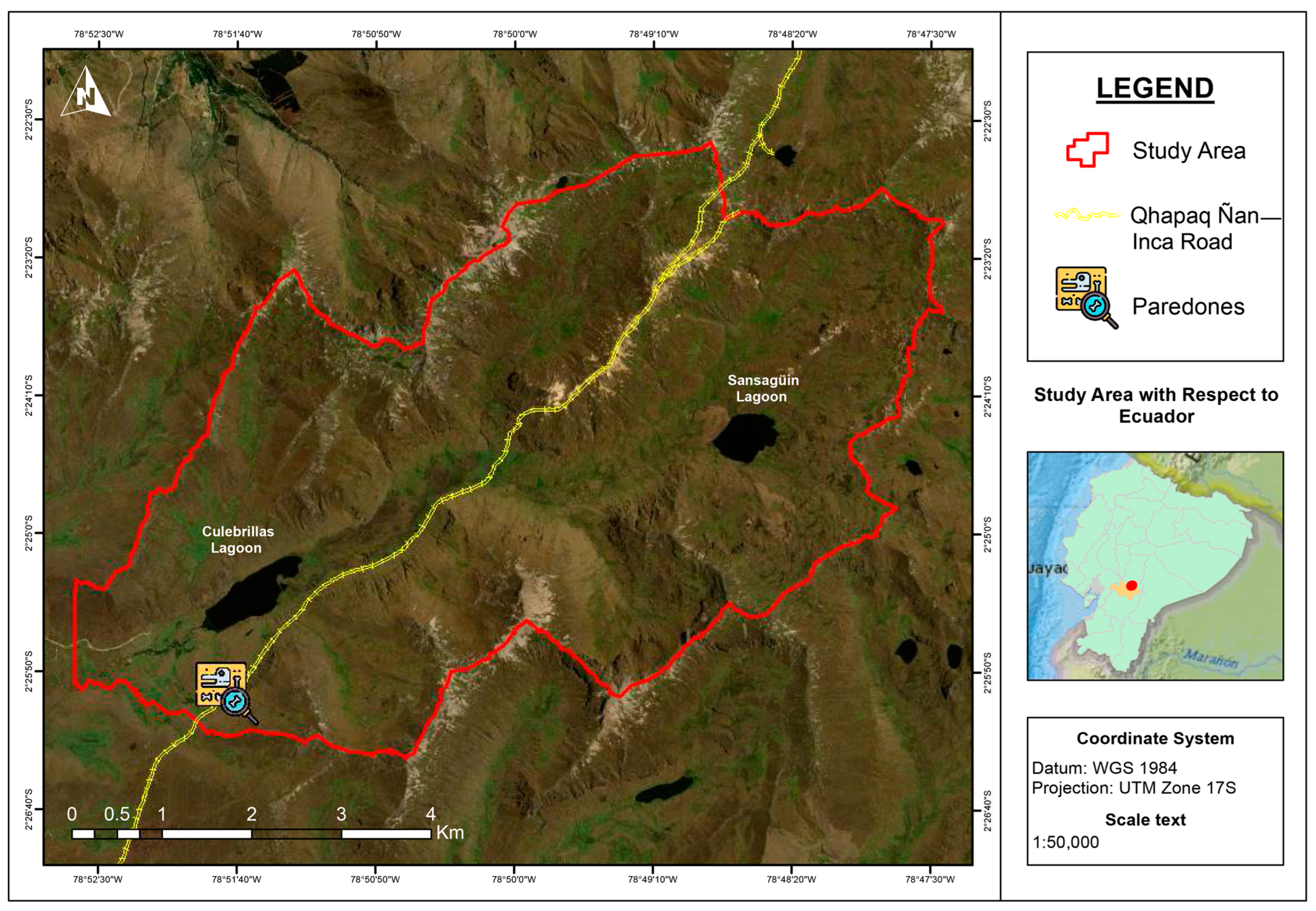
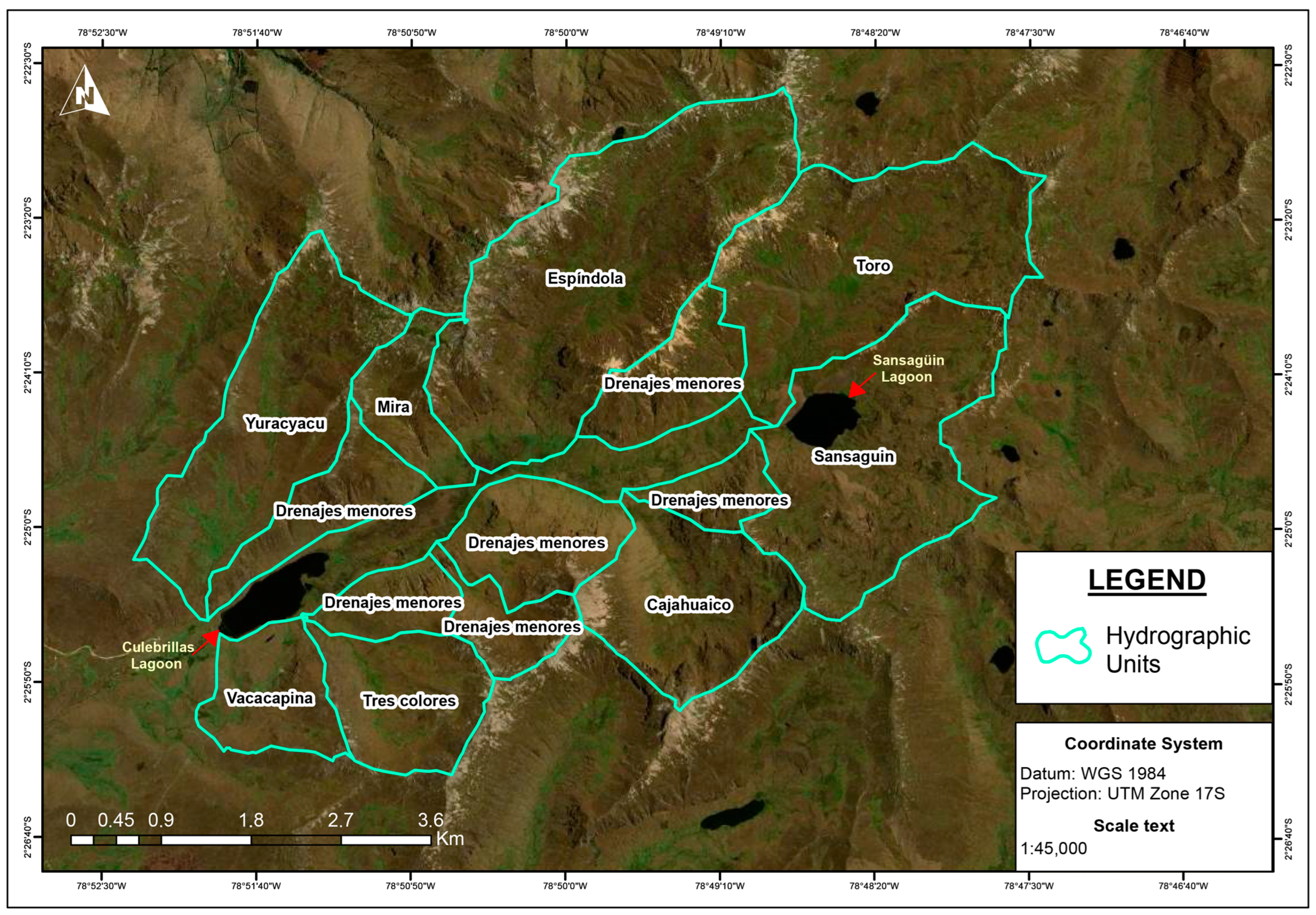

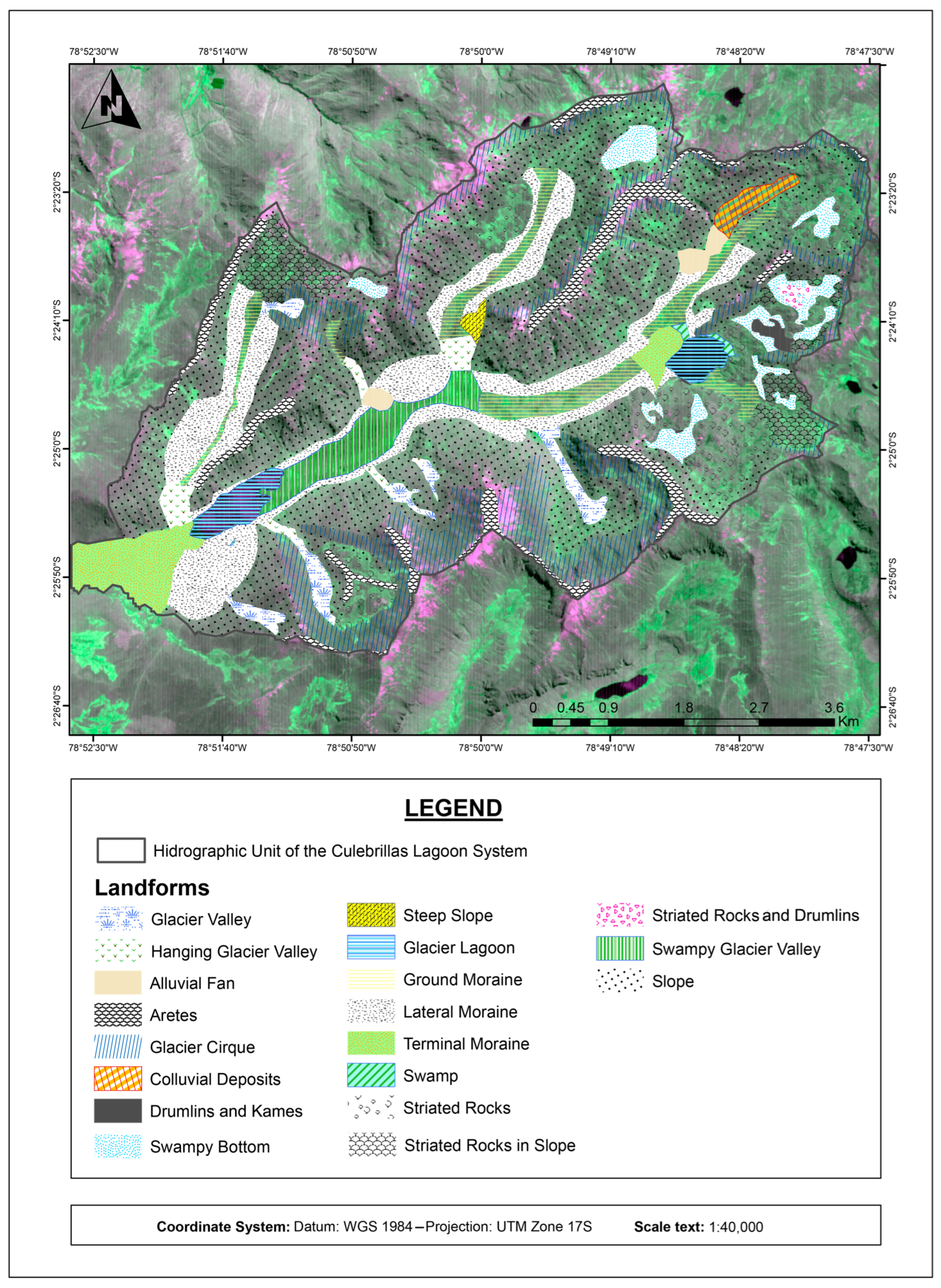
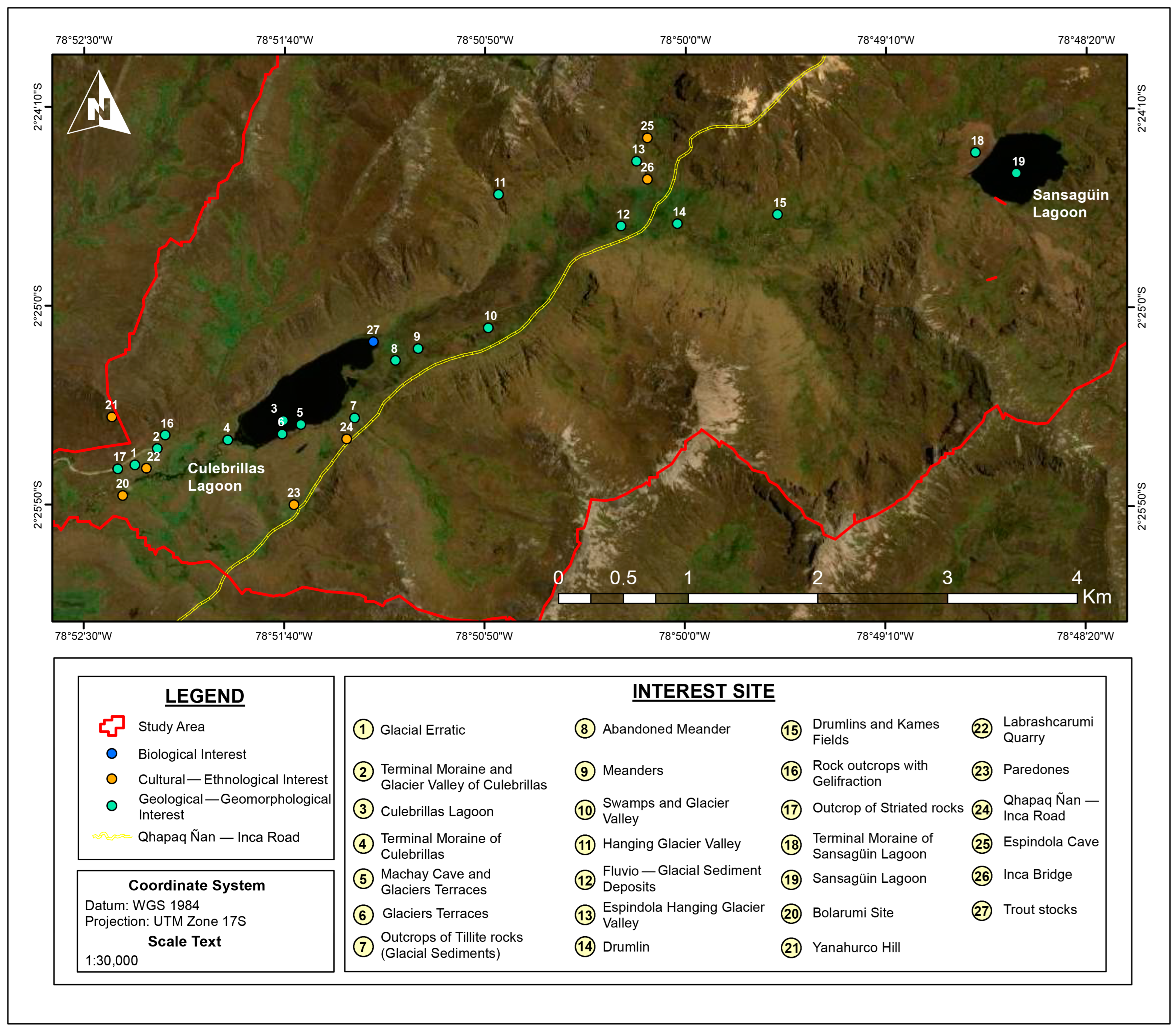
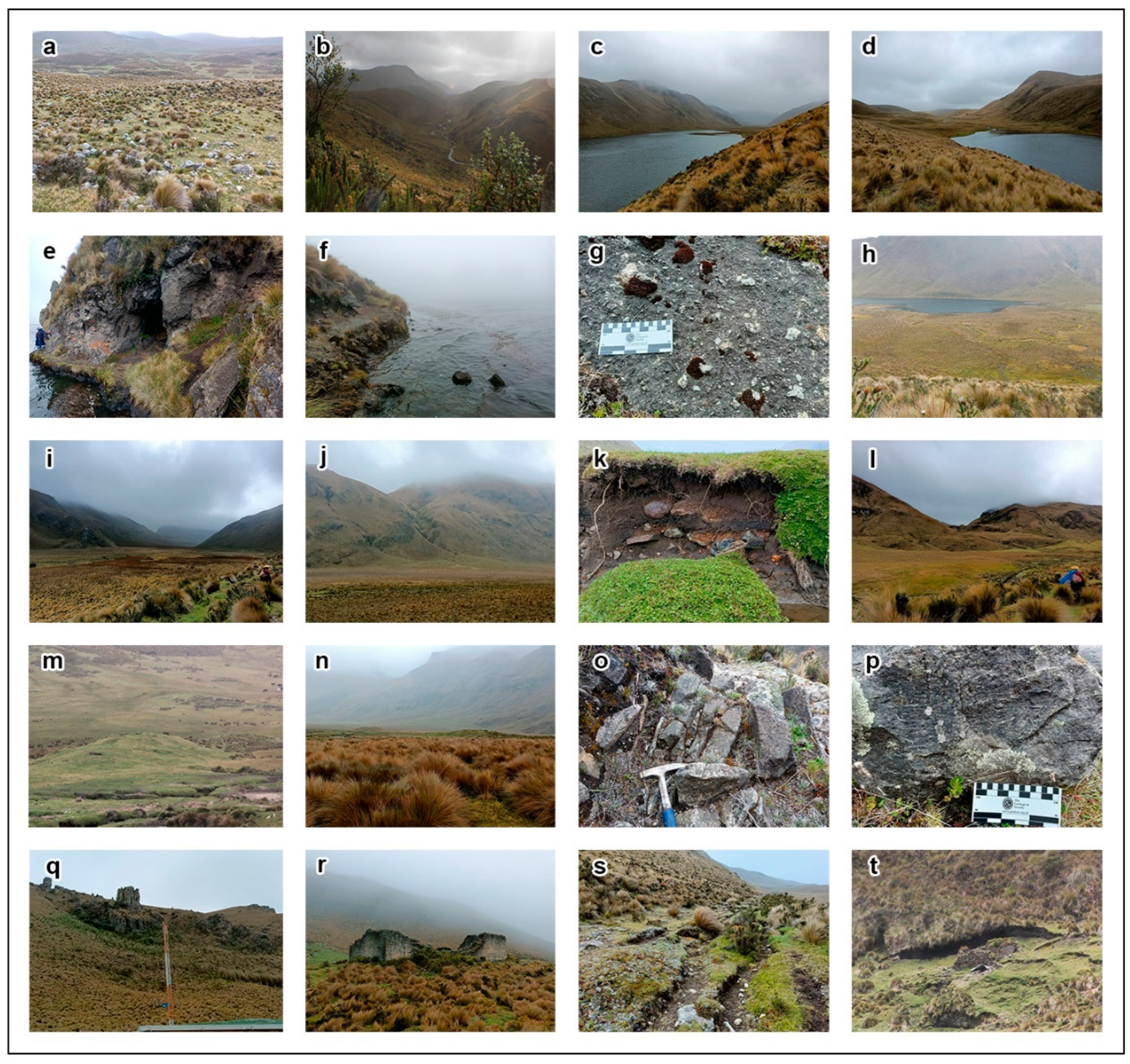
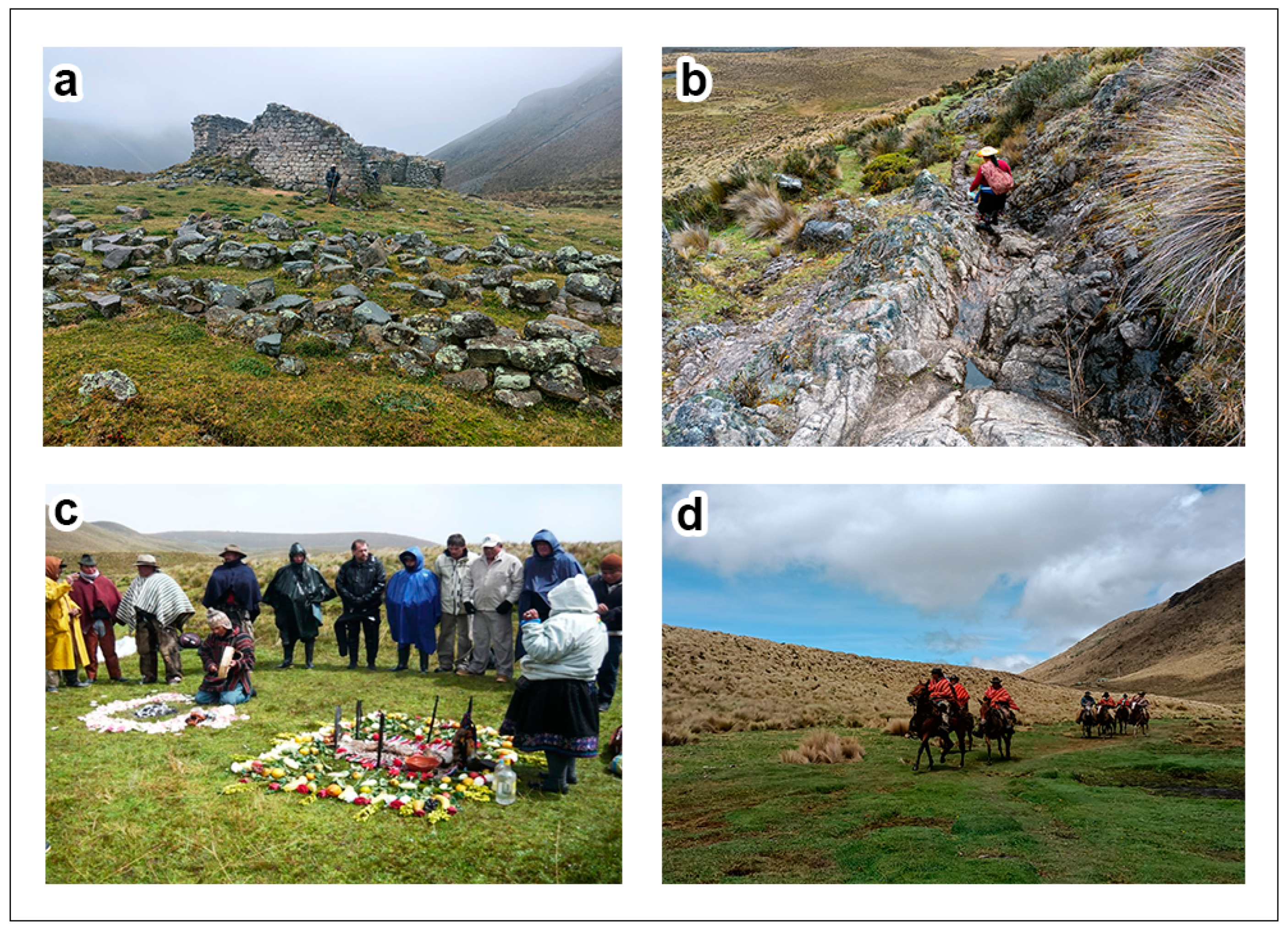

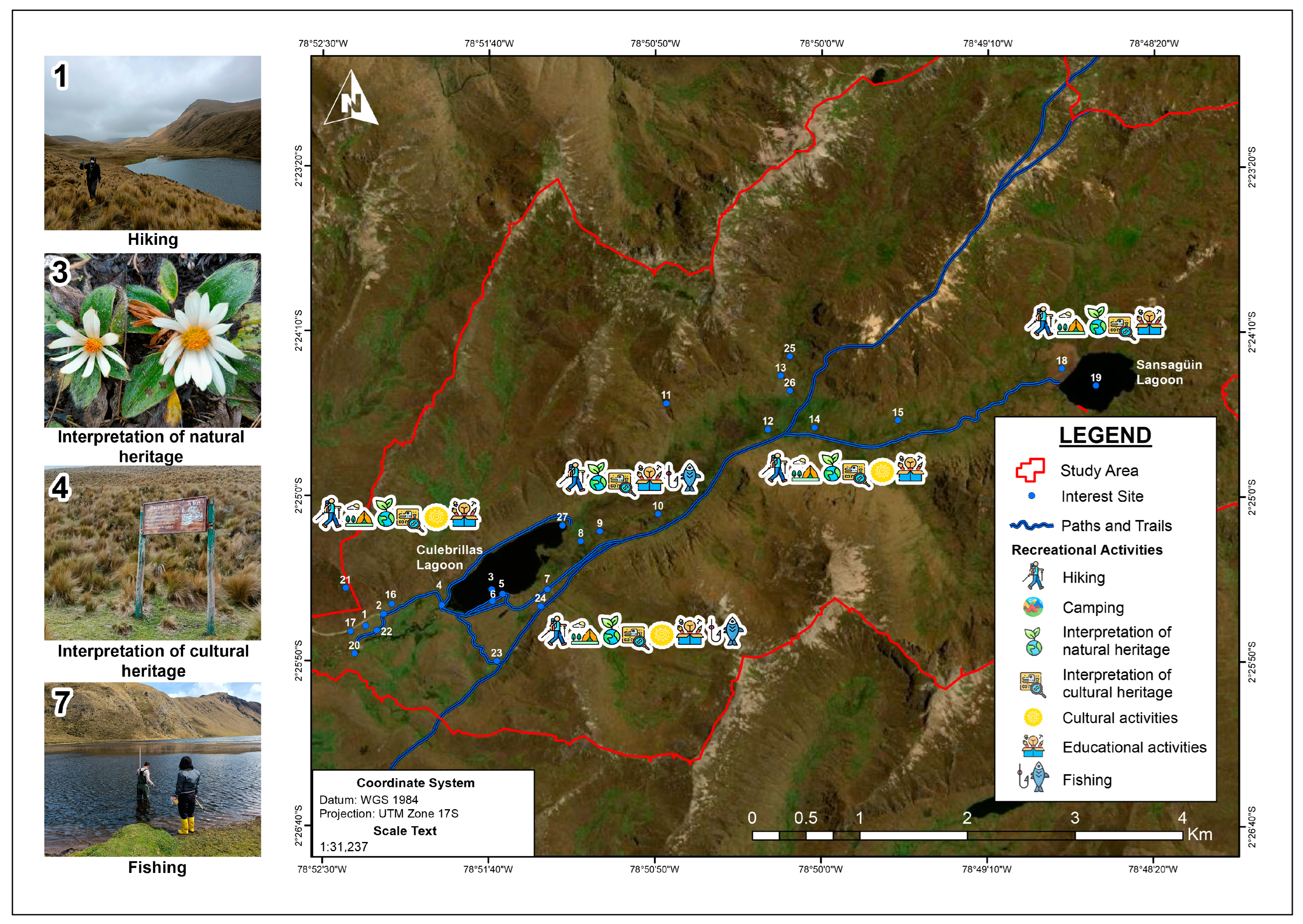
| Parameter | Description | Weighting | Weighting Value |
|---|---|---|---|
| 1. Main Interests | It is established whether a site has multiple interests; the more interests it possesses, the greater will be its relative weighting. | Very high | 5 |
| High | 4 | ||
| Middle | 3 | ||
| Low | 2 | ||
| Very low | 1 | ||
| 2. Superlative Value | This is established as a criterion to determine a site’s uniqueness value, or singularity if it is a unique example at the national level; the greater the uniqueness, the greater will be its weighting. | Very high | 5 |
| High | 4 | ||
| Middle | 3 | ||
| Low | 2 | ||
| Very low | 1 | ||
| 3. Potential Uses | It is established whether different activities can be conducted at a site or if there are different uses of a site; the greater the number of potential activities or uses, the greater will be its weighting. | 5 or more potential uses | 5 |
| 4 potential uses | 4 | ||
| 3 potential uses | 3 | ||
| 2 potential uses | 2 | ||
| 1 potential use | 1 | ||
| 4. State of Conservation | This is established as the current condition or state of a site; the greater the state of conservation, the greater will be the weighting. | Very high | 5 |
| High | 4 | ||
| Middle | 3 | ||
| Low | 2 | ||
| Very low | 1 | ||
| 5. Degree of Vulnerability | This is established as a site’s susceptibility to damage, loss, or threat; the greater the vulnerability, the lower will be the weighting. | Very low | 5 |
| Low | 4 | ||
| Middle | 3 | ||
| High | 2 | ||
| Very high | 1 |
| ID. | Interest Site | Interest Type | Parameters | Total | Geotouristic Potential | ||||
|---|---|---|---|---|---|---|---|---|---|
| 1 | 2 | 3 | 4 | 5 | |||||
| 1 | Glacial Erratic | GL-GM-CU-ET | 5 | 3 | 3 | 4 | 3 | 18 | Middle |
| 2 | Terminal Moraine and Glacier Valley of Culebrillas | GL-GM | 3 | 4 | 4 | 5 | 4 | 20 | High |
| 3 | Culebrillas Lagoon | GL-GM-CU-ET | 5 | 5 | 5 | 5 | 4 | 24 | High |
| 4 | Terminal Moraine of Culebrillas | GL-GM | 3 | 3 | 5 | 5 | 4 | 20 | High |
| 5 | Machay Cave and Glaciers Terraces | GL-GM-CU-ET | 5 | 3 | 5 | 5 | 4 | 22 | High |
| 6 | Glaciers Terraces | GL-GM-CU-ET | 5 | 3 | 3 | 5 | 4 | 20 | High |
| 7 | Outcrops of Tillite rocks (Glacial Sediments) | GL-GM | 2 | 3 | 3 | 5 | 4 | 17 | Middle |
| 8 | Abandoned Meander | GL-GM | 3 | 4 | 4 | 5 | 4 | 20 | High |
| 9 | Meanders | GL-GM-CU-ET | 5 | 3 | 5 | 5 | 4 | 22 | High |
| 10 | Swamps and Glacier Valley | GL-GM | 3 | 3 | 4 | 5 | 4 | 19 | High |
| 11 | Hanging Glacier Valley | GL-GM | 2 | 3 | 3 | 5 | 4 | 17 | Middle |
| 12 | Fluvio–Glacial Sediment Deposits | GL-GM | 2 | 3 | 3 | 5 | 4 | 17 | Middle |
| 13 | Espindola Hanging Glacier Valley | GL-GM-CU-ET | 4 | 3 | 4 | 5 | 4 | 20 | High |
| 14 | Drumlin | GL-GM | 3 | 3 | 3 | 5 | 4 | 18 | Middle |
| 15 | Drumlins and Kames Fields | GL-GM | 3 | 4 | 3 | 5 | 4 | 19 | High |
| 16 | Rock outcrops with Gelifraction | GL-GM | 2 | 3 | 3 | 5 | 4 | 17 | Middle |
| 17 | Outcrop of Striated rocks | GL-GM | 2 | 3 | 3 | 5 | 4 | 17 | Middle |
| 18 | Terminal Moraine of Sansagüin Lagoon | GL-GM | 2 | 4 | 4 | 5 | 5 | 20 | High |
| 19 | Sansagüin Lagoon | GL-GM-CU-ET | 5 | 5 | 5 | 5 | 4 | 24 | High |
| 20 | Bolarumi Site | CU-ET | 3 | 5 | 4 | 4 | 3 | 19 | High |
| 21 | Yanahurco Hill | GL-GM-CU-ET | 5 | 4 | 5 | 5 | 4 | 23 | High |
| 22 | Labrashcarumi Quarry | CU-ET | 3 | 5 | 5 | 4 | 3 | 20 | High |
| 23 | Paredones | CU-ET | 3 | 5 | 5 | 4 | 3 | 20 | High |
| 24 | Qhapaq Ñan—Inca Road | GM-CU-ET | 4 | 5 | 5 | 5 | 3 | 22 | High |
| 25 | Espindola Cave | GL-GM-CU-ET | 5 | 4 | 5 | 5 | 4 | 23 | High |
| 26 | Inca Bridge | CU-ET | 3 | 4 | 4 | 5 | 4 | 20 | High |
| 27 | Trout stocks | BL | 1 | 3 | 4 | 5 | 3 | 16 | Middle |
Disclaimer/Publisher’s Note: The statements, opinions and data contained in all publications are solely those of the individual author(s) and contributor(s) and not of MDPI and/or the editor(s). MDPI and/or the editor(s) disclaim responsibility for any injury to people or property resulting from any ideas, methods, instructions or products referred to in the content. |
© 2023 by the authors. Licensee MDPI, Basel, Switzerland. This article is an open access article distributed under the terms and conditions of the Creative Commons Attribution (CC BY) license (https://creativecommons.org/licenses/by/4.0/).
Share and Cite
Sánchez-Cortez, J.L.; Vélez-Macías, K.; Macas-Espinosa, V.; Naranjo-Freire, C. Characterization of Geoheritage and Geotourism Potential of the Fluvial-Glacial Landscapes in the Culebrillas Lagoon (Ecuador). Tour. Hosp. 2023, 4, 419-434. https://doi.org/10.3390/tourhosp4030026
Sánchez-Cortez JL, Vélez-Macías K, Macas-Espinosa V, Naranjo-Freire C. Characterization of Geoheritage and Geotourism Potential of the Fluvial-Glacial Landscapes in the Culebrillas Lagoon (Ecuador). Tourism and Hospitality. 2023; 4(3):419-434. https://doi.org/10.3390/tourhosp4030026
Chicago/Turabian StyleSánchez-Cortez, José Luis, Kathleen Vélez-Macías, Vinicio Macas-Espinosa, and Clelia Naranjo-Freire. 2023. "Characterization of Geoheritage and Geotourism Potential of the Fluvial-Glacial Landscapes in the Culebrillas Lagoon (Ecuador)" Tourism and Hospitality 4, no. 3: 419-434. https://doi.org/10.3390/tourhosp4030026
APA StyleSánchez-Cortez, J. L., Vélez-Macías, K., Macas-Espinosa, V., & Naranjo-Freire, C. (2023). Characterization of Geoheritage and Geotourism Potential of the Fluvial-Glacial Landscapes in the Culebrillas Lagoon (Ecuador). Tourism and Hospitality, 4(3), 419-434. https://doi.org/10.3390/tourhosp4030026






